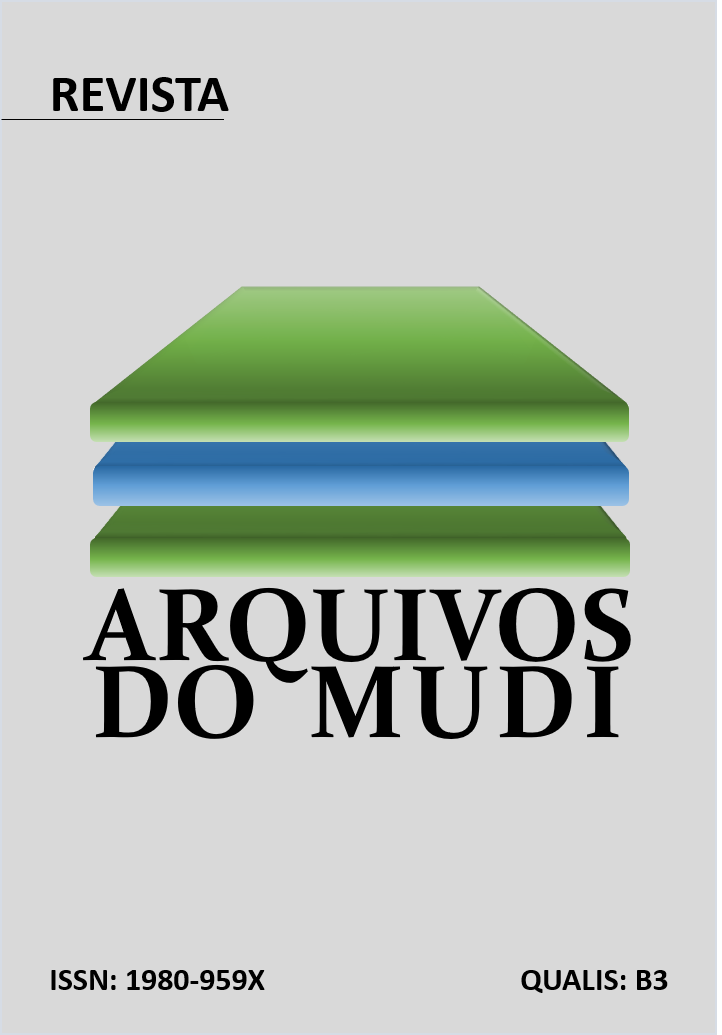CARACTERÍSTICAS QUÍMICAS, MICROBIOLÓGICAS E NUTRICIONAIS DA KOMBUCHA: UMA REVISÃO NARRATIVA DA LITERATURA
Abstract
Kombucha is a traditional drink that originated in Manchuria – China, and has been consumed all over the world due to its unique flavor and healthy properties. It is produced by fermenting sweetened tea leaves of Camellia sinensis with bacteria and yeast, producing beneficial substances for human health including organic acids, vitamins, enzymes, and antioxidants. The healthy food market has grown in recent years due to consumers' awareness of the importance of good nutrition and its impact on quality of life. This study is a literature review aimed at compiling information about Kombucha and highlighting its microbiological, biochemical, and nutritional aspects, as well as information about its production.
Downloads
References
BARBOSA, C. D.; SANTOS, W.C.R.; GOMES, D.; ALBANO, H.C.; TEIXEIRA, P.C.M.; ROSA. C.A.; ALVARENGA, V.O.; LACERDA, I. C. A. Caracterização fisíco-química, microbiológica e quantificação de compostos fenólicos de Kombucha. In: SIMPÓSIO LATINO-AMERICANO DE CIÊNCIA DE ALIMENTOS, 13., 2019, Campinas. Anais eletrônicos [...]. Campinas: Galoá, 2019.
BAUER-PETROVSKA, B.; PETRUSHEVSKA-TOZI, L. Mineral and water-soluble vitamin contents in the Kombucha drink. International Journal of Food Science and Technology, v. 35, n. 2, p. 201-205, 2000.
CHAWLA, P. R.; BAJAJ, I. B.; SURVASE, S. A.; SINGHAL, R. S. Microbial cellulose: Fermentative production and applications. Food Technology and Biotechnology, v. 47, n. 2, p. 107-124, 2009.
CHEN, C.; LIU, B. Y. Changes in major components of tea fungus metabolites during prolonged fermentation. Journal of Applied Microbiology, v. 89, n. 5, p. 834-839, 2000.
COTON, M.; PAWTOWSKI, A.; TAMINIAU, B.; BURGAUD, G.; DENIEL, F.; COULLOUMME-LABARTHE, L.; COTON, E. Unraveling microbial ecology of industrial-scale Kombucha fermentations by metabarcoding and culture-based methods. FEMS Microbiology Ecology, v. 93, n. 5, p. 1-16, 2017.
CZAJA, W.; KRYSTYNOWICZ, A.; BIELECKI, S.; BROWN, M. Microbial cellulose: The natural power to heal wounds. Biomaterials, v, 27, n. 2, p. 145-151, 2006.
DADA, A. P.; LAZZARI, A.; CESTÁRIO, A. C. O.; SILVA, D. S.; SARAIVA, B. R.; ROSA, C. I. L. F.; PINTRO, P. T. M. Caracterização de kombucha elaborado a partir de chá verde. Research, Society and Development, v. 10, n. 15, 2021.
DUTTA, H.; PAUL, S. K. Kombucha Drink: Production, Quality, and Safety Aspects. In: GRUMEZESCU, A.; HOLBAN, A. M. (ed.). Production and Management of Beverages 1: The Science of Beverages. Sawston: Woodhead Publishing, 2019. p. 259-288.
FU, C.; YAN, F.; CAO, Z.; XIE, F.; LIN, J. Antioxidant activities of kombucha prepared from three different substrates and changes in content of probiotics during storage. Food Science and Technology, v. 34, n. 1, p. 123-126, 2014.
GAMUNDI, R.; VALDIVIA, M. El hongo Kombucha: Dos opiniones distintas. Sidahora, v. 10-11, p. 34-34, 1995.
GOH, W. N.; ROSMA, A.; KAUR, B.; EAZILAH, A.; KARIM, A. A.; BHAT, R. Fermentation of black tea broth (Kombucha): I. Effects of sucrose concentration and fermentation time on the yield of microbial cellulose. International Food Research Journal, v. 19, n. 1, p. 109-117, 2012.
GREENWALT, C. J.; LEDFORD, R. A., STEINKRAUS, K. H. Determination and characterization of the antimicrobial activity of the fermented tea kombucha. LWT: Food, Science and Technology, v. 31, n. 3, p. 291-296, 1998.
HAUSER, S. P. Teepilz Kombucha nach Dr. med. Sklenar: Eine biologische Krebstherapie. Dokumentation Nr. 18. Schweizerische Rundschau fur Medizin Praxis, v. 79, n. 9, p. 243-246, 1990.
HESSELTINE, C. W. A millennium of fungi: Food and fermentation. Mycologia, v. 77, n. 2, p. 148-167, 1965.
JAYABALAN, R.; MALBAŠA, R. V.; LONČAR, E. S.; VITAS, J. S.; SATHISHKUMAR, M. A review on Kombucha tea: Microbiology, composition, fermentation, beneficial effects, toxicity, and tea fungus. Comprehensive Reviews in Food Science and Food Safety, v. 13, n. 4, p. 538-550, 2014.
JAYABALAN, R.; MALINI, K.; SATHISHKUMAR, M.; SWAMINATHAN, K.; YUN, S. E. Biochemical characteristics of tea fungus produced during kombucha fermentation. Food Science and Biotechnology, v. 19, p. 843-847, 2010.
JAYABALAN, R.; MARIMUTHU, S.; SWAMINATHAN, K. Changes in content of organic acids and tea polyphenols during kombucha tea fermentation. Food Chemistry, v. 102, p. 392-398, 2007.
JAYABALAN, R.; SUBATHRADEVI, P.; MARIMUTHU, S.; SATHISHKUMAR, M.; SWAMINATHAN, K. Changes in free-radical scavenging ability of kombucha tea during fermentation. Food Chemistry, v. 109, n. 1, p. 227-234, 2008.
LONČAR, E. S.; PETROVIĆ, S. E.; MALBAŠA, R. V.; VERAC, R. M. Biosynthesis of glucuronic acid by means of tea fungus. Molecular Nutrition & Food Research, v. 44, n. 2, p. 138-139, 2000.
LONČAR, E.; DJURIĆ, M.; MALBAŠA, R.; KOLAROV, L.; KLAŠNJA, M. Influence of working conditions upon kombucha conducted fermentation of black tea. Food and Bioproducts Processing, v. 84, n. 3, p. 186-192, 2006.
MALBAŠA, R. V.; LONČAR, E. S.; KOLAROV, L. J. A. Sucrose and inulin balance during tea fungus fermentation. Romanian Biotechnological Letters, v. 7, p. 573-576, 2002.
MALBAŠA, R. V.; LONČAR, E. S.; VITAS, J. S.; ČANADANOVIĆ-BRUNET, J. M. Influence of starter cultures on the antioxidant activity of Kombucha beverage. Food Chemistry, v. 127, p. 1727-1731, 2011.
MALBAŠA, R.; LONČAR, E.; DJURIĆ, M.; KLAŠNJA, M.; KOLAROV, L.; MARKOV, S. Scale-up of black tea batch fermentation by kombucha. Food and Bioproducts Processing, v. 84, n. 3, p. 193-199, 2006.
MARSH, A. J.; O’SULLIVAN, O.; HILL, C.; ROSS, R. P.; COTTER, P. D. Sequence-based analysis of the bacterial and fungal compositions of multiple Kombucha (tea fungus) samples. Food Microbiology, v. 38, p. 171-178, 2014.
MINISTÉRIO DA AGRICULTURA, PECUÁRIA E ABASTECIMENTO. Instrução Normativa nº 41, de 17 de setembro de 2019. Diário Oficial da União: seção 1, Brasília, DF, n. 181, p. 13, 18 set. 2019.
MOHAMMADSHIRAZI, A.; KALHOR, E. B. Energy and cost analyses of kombucha beverage production. Renewable and Sustainable Energy Reviews, v. 55, p. 668-673, 2016.
NGUYEN, N. K.; NGUYEN, P. B.; NGUYEN, H. T.; LE, P. H. Screening the optimal ratio of symbiosis between isolated yeast and acetic acid bacteria strain from traditional Kombucha for high-level production of glucuronic acid. LWT: Food, Science and Technology, v. 64, n. 2, p. 1149-1155, 2015.
ROOS, J. D.; VUYST, L. D. Acetic acid bacteria in fermented foods and beverages. Current Opinion in Biotechnology, v. 49, p. 115-119, 2018.
SABOURAUD, S.; COPPÉRÉ, B.; ROUSSEAU, C.; TESTUD, F.; PULCE, C.; THOLLY, F.; BLANC, M.; CULOMA, F.; FACCHIN, A.; NINET, J.; CHAMBON, P.; MEDINA, B.; DESCOTES, J. Intoxication environnementale par le plomb liée à la consommation de boisson conservée dans une cruche artisanale en céramique vernissée. Revue de Médecine Interne, v. 30, n. 12, p. 1038-1043, 2009.
SIEVERS, M.; LANINI, C.; WEBER, A.; SCHULER-SCHMID, U.; TEUBER, M. Microbiology and fermentation balance in a kombucha beverage obtained from a tea fungus fermentation. Systematic and Applied Microbiology, v. 18, p. 590-594, 1995.
SILVA, E. P.; SANTOS, L. S.; RAPOSO, L. E. P.; SODRÉ, H. P.; BATISTA, M. O. Controle de qualidade de polpas industrializadas e artesanais de caju. Conjecturas, v. 22, n. 11, p. 29-43, 2022.
SRINIVASAN, R.; SMOLINSKE, S.; GREEBAUM, D. Probable gastrointestinal toxicity of Kombucha tea: is this beverage healthy or harmful? Journal of General Internal Medicine, v. 12, n. 10, p. 643-645, 1997.
STANBURY, P. F.; WHITAKER, A.; HALL, S. J. Principles of fermentation technology. Journal of Chemical Information and Modeling, v. 53, n. 9, p. 1689-1699, 2013.
SUZUKI, Y.; MIYOSHI, N.; ISEMURA, M. Health-promoting effects of green tea. Proceedings of the Japan Academy, Ser. B, v. 88, n. 3, p. 88-101, 2012.
VELIĆANSKI, A. S.; CVETKOVIĆ, D. D.; MARKOV, S. L.; TUMBAS, V. T.; SAVATOVIĆ, S. M. Antimicrobial and antioxidant activity of lemon balm kombucha. Acta Periodica Technologica, v. 38, p. 165-172, 2007.
VIJAYARAGHAVAN, R.; SINGH, M.; RAO, P. V. L.; BHATTACHARYA, R.; KUMAR, P.; SUGENDRAN, K.; KUMAR, O.; PANT, S. C.; SINGH, R. Subacute (90 days) oral toxicity studies of Kombucha tea. Biomedical and Environmental Sciences, v. 13, n. 4, p. 293-299, 2000.
VILLARREAL-SOTO, S. A.; BEAUFORT, S.; BOUAJILLA, J.; SOUCHARD, J.; TAILLANDIER, P. Understanding Kombucha Tea Fermentation: A Review. Journal of Food Science, v. 83, n. 3, p. 580-588, 2018.
VITAS, J. S.; MALBAŠA, R. V.; GRAHOVAC, J. A.; LONČAR, E. S. The antioxidant activity of Kombucha fermented milk products with stinging nettle and winter savory. Chemical Industry & Chemical Engineering Quarterly, v. 19, n. 1, p. 129-139, 2013.
WANG, K.; GAN, X.; TANG, X.; WANG, S.; TAN, H. Determination of D-saccharic acid-1,4-lactone from brewed kombucha broth by high-performance capillary electrophoresis. Journal of Chromatography B: Analytical Technologies in the Biomedical and Life Sciences, v. 878, n. 3, p. 371-374, 2010.
WATAWANA, M. I.; JAYAWARDENA, N.; RANASINGHE, S. J.; WAISUNDARA, V. Y. Evaluation of the Effect of Different Sweetening Agents on the Polyphenol Contents and Antioxidant and Starch Hydrolase Inhibitory Properties of Kombucha. Journal of Food Processing and Preservation, v. 41, n. 1, 2017.
YANG, Z.; ZHOU, F.; JI, B.; LI, B.; LUO, Y.; YANG, L.; LI, T. Symbiosis between microorganisms from kombucha and kefir: Potential significance to the enhancement of kombucha function. Applied Biochemistry and Biotechnology, v. 160, n. 2, p. 446-455, 2010.
DECLARAÇÃO DE ORIGINALIDADE E DIREITOS AUTORAIS
Declaro que o presente artigo é original, não tendo sido submetido à publicação em qualquer outro periódico nacional ou internacional, quer seja em parte ou em sua totalidade.
Os direitos autorais pertencem exclusivamente aos autores. Os direitos de licenciamento utilizados pelo periódico é a licença Creative Commons Attribution 4.0 (CC BY ): são permitidos o acompartilhamento (cópia e distribuição do material em qualqer meio ou formato) e adaptação (remix, transformação e criação de material a partir do conteúdo assim licenciado para quaisquer fins, inclusive comerciais.

Recomenda-se a leitura desse link para maiores informações sobre o tema: fornecimento de créditos e referências de forma correta, entre outros detalhes cruciais para uso adequado do material licenciado.

















